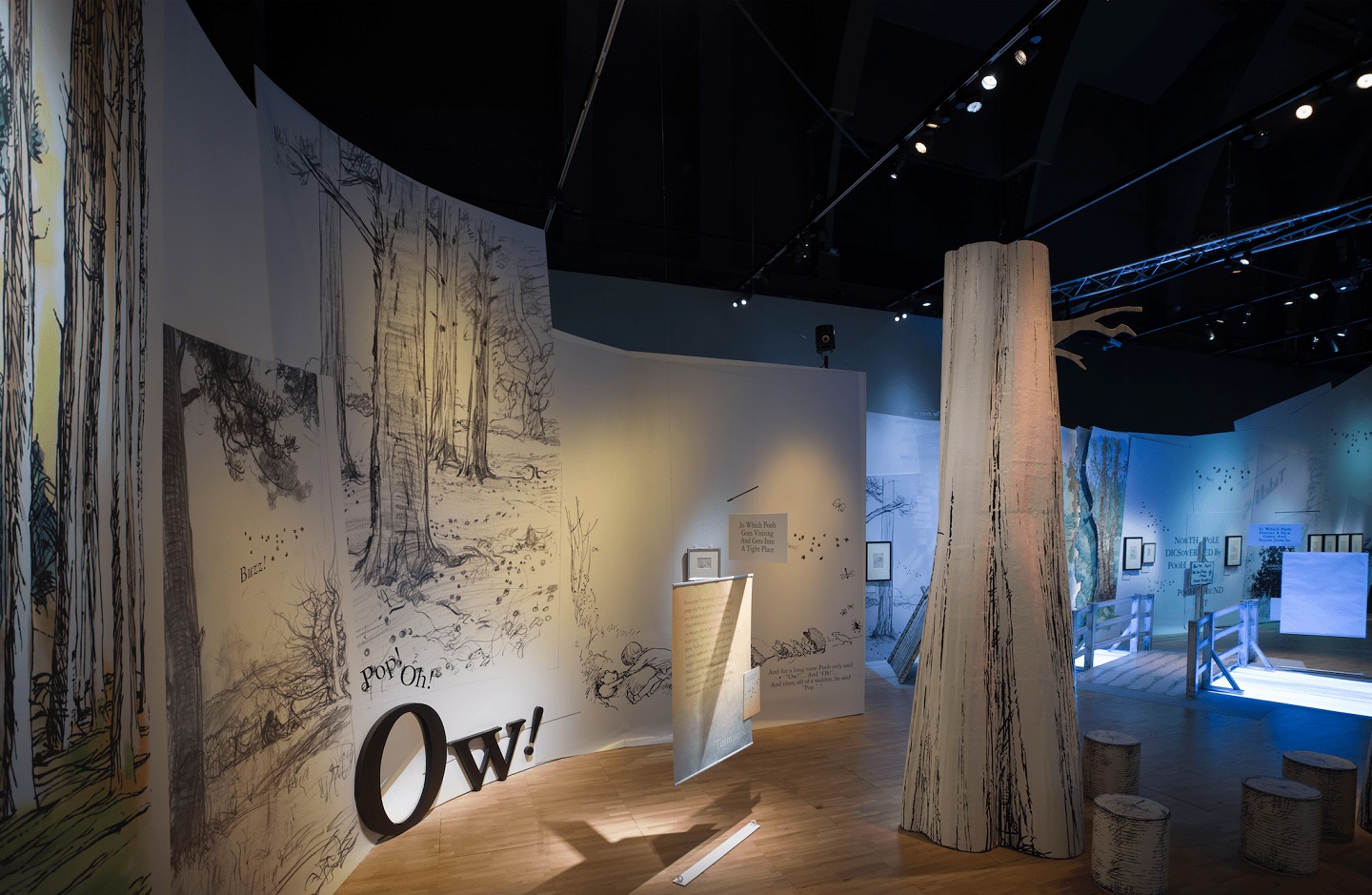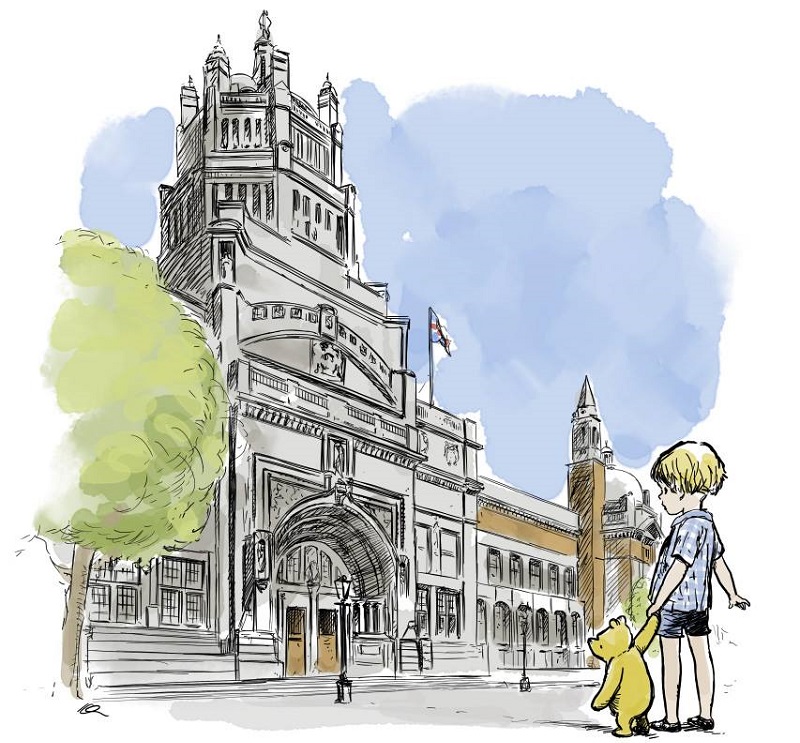
(Photo: Victoria & Albert Museum)
It is not very dignified to be dragged downstairs by one’s leg but Edward Bear is a teddy and though he can Think of Things, he cannot quite articulate a better descent. Bump, bump, bump goes his head on the steps as his young master Christopher Robin seeks out his father to ask for a bedtime story, supposedly on Edward’s behalf. It quickly transpires that Edward has been spontaneously but firmly rechristened Winnie-the-Pooh, and the tale is to be one about himself because he is “that sort of bear”.
Whether you are three or 93, this prefix may ring familiar. It is only, after all, the introduction to one of the most beloved classics of this past century, a saga of dubious decisions and madcap escapades by an especially motley crew. Author AA Milne was inspired to write Winnie, Kanga, Roo, Tigger, Eeyore, Rabbit and Owl to life after watching their stuffed namesakes enliven the days of his son, the real Christopher Robin.
First published in 1926, the simply titled Winnie-the-Pooh immediately enchanted children and adults alike with its highly textured adventures, rhythmic prose and the charming illustrations wrought by the hand of Ernest H Shepard. The characters grappled with outrageous scenarios and nuanced emotions in tales so rich in innocence, wit and wisdom that bedtime became that much more interesting for reader and listener.
Nine decades and several generations later, its eternal universal themes see these stories, since translated into 30 languages, still shared. The Victoria & Albert Museum in London gave the literary stalwart a fitting reception by hosting the largest exhibition of its kind ever held in the UK. Some 230 items showcase the inspirations behind the Bear of Very Little Brain and explore the relationship between Milne and Shepard as they dreamt the menagerie in the nursery to life. The diversity of its anticipated audience — chiefly the polarity of ages — is effortlessly exemplified with exhibits running from playful to sophisticated.

Winnie-the-Pooh: Exploring a Classic opens with a display of memorabilia dating from the 1920s to the present day. Inside glass-fronted showcases are black-and-white advertisements from The Sunday Times with the bear — in colour for contrast — inviting readers to follow him to the best jobs or the best homes within the newspaper. Crossovers into other realms include a Star Wars sketch of Wookie the Chew parodying Winnie. “It says that the force has a light side and a dark side,” says Chrisolo Robin. “I think,” sighs Chew, “that I might be a little too heavy for the light side.” Also present are figures and merchandise by Disney, Teddy Toy Company, and Fullham Pottery. One of the most intriguing displays is a 1928 hand-painted Christopher Robin nursery tea set by Ashtead Pottery presented to Princess Elizabeth, who shares the same birth year as Pooh.
The black walls of the reception area segue into blue-and-white striped wallpaper, akin to that of a boy’s bedroom. Murals depicting iconic scenes and quotes, as well as life-sized faux trees contribute to the immersive atmosphere throughout. Cordoned off in the middle of the wide space is a “playpen”, with a low-cut door ensuring only little visitors can duck through to discover the mysteries within.
On the walls surrounding this are framed original sketches, manuscripts and letters between Milne and Shepherd that give insight into their relationship. The two were introduced through British magazine Punch, at which Milne was assistant editor. An accomplished writer, his work as at then included humorous verses, social satire, fairy tales, plays and a murder-mystery novel.
These painstaking renderings would later even influence language, with names becoming synonymous with their traits, such as Eeyorish to describe gloominess and Tiggerish for liveliness or boisterousness
In Ashdown Forest near the Milnes’ weekend retreat in East Sussex, Christopher Robin used to play pretend with his favourite toy, the long-limbed Winnie-the-Pooh, who took his name from a black bear at the London Zoo (Winnipeg) and a swan named Pooh by his father. Milne would make up stories of the friends’ adventures while his wife literally gave them voice by acting out the different characters at bedtime. The forest, known to fans as Hundred Acre Wood, is the famous setting for their “expositions”, expeditions that began at a large walnut tree that is The House at Pooh Corner. On display is a framed letter Milne wrote to Shepherd, imploring him to visit them “if only to get Pooh’s and Piglet’s likeness”. Shepherd acquiesced, meticulously capturing the aesthetic that inspired the stories, but also referencing his own son Graham and his teddy, Growler, in developing the visuals.
Visitors are drawn deeper and deeper into the fictitious universe as the exhibition progresses. For children, this comes with interactive traditional and multimedia displays, including a crossing of the famed Pooh Bridge. While the young ones are so occupied, the adults can examine the collection at their leisure.

In a corner, visitors can listen to the only known recording of Milne reading from one of his Pooh books. It is a surreal experience, judging by the visitors who make themselves comfortable on benches and listen with their eyes closed and lips tugged upwards. Along a corridor-like trail are treasures of similar rarity, working sketches that show how the characters’ postures and expressions embodied their personality. These painstaking renderings would later even influence language, with names becoming synonymous with their traits, such as Eeyorish to describe gloominess and Tiggerish for liveliness or boisterousness. Further down, the creative process is detailed to demonstrate the tales’ development from conceptualisation and production on paper to animation in the later years.
Sourced from the V&A archives, Walt Disney Company, Egmont Publishing, the Shepard Trust, the University of Surrey and Trinity College, Cambridge, the collection is a trove of wonder for visitors, regardless of their familiarity with the subject. That said, it naturally moves the fan more, particularly older enthusiasts for whom this trip down memory lane is shared with youngsters who recently experienced or are currently experiencing the world of Winnie. Ahead of me is an elderly English couple with their granddaughter, who pore over the pieces with infectious delight. “I don’t remember the woozles, do you, grandma?” asks the latter. As with most multi-generational groups of visitors, it is hard to tell who is more enraptured.
And it is this that testifies to Milne’s success with Winnie-the-Pooh, garlanding him the unofficial laureate of the nursery. Unlike his Pooh adventures, Milne’s own real-life story did not exactly end happily. The adult Christopher Robin was reportedly estranged from his parents, though the 2017 movie, Goodbye Christopher Robin, might claim liberal artistic licence in telling this tale. However, that does not take away from the fact that for millions of families around the world, the imagination of a father, mother and son was the making of beautiful memories to be shared with generations to come.
'Winnie-the-Pooh: Exploring a Classic' is on display at the Victoria & Albert Museum in London until April 8. Tickets are priced at £8, with certain concessions applicable. This article first appeared on Feb 5, 2018 in The Edge Malaysia.


